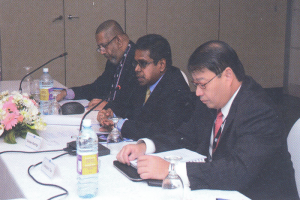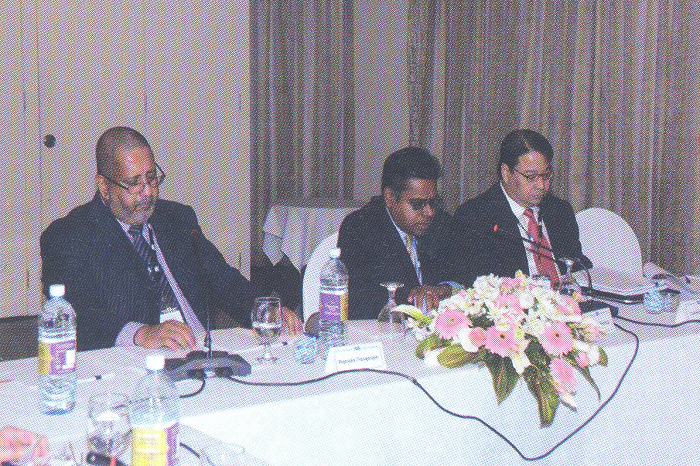Promoting Preparedness for Operational / Severe Event Risk Among Banks in the Asia-Pacific Region
1. The Asian Bankers Association (ABA) is keenly aware of severe event risk and its possible major consequences on the operations and reputation of banks. The media has been broadcasting the phenomenon of global climate change and the apparently intensifying and increasing weather disturbances that occur as a consequence. There have been many natural disasters that have taken place in various parts of the world including many parts of Asia from earthquakes and tsunamis, to typhoons and floods, accompanied by catastrophes such as fires that may result from the initial earthquake, for example.
2. The ABA recognizes that in the case of natural disasters, there is little that can be done to prevent them from occurring as these are acts of nature. However there are many activities that can be undertaken as a first step or line of defense to possibly prevent damage as a consequence of these natural occurrences. For instance, a bank may deliberately locate its branch offices on higher ground to avoid being flooded, or observe building construction strength guidelines that are above local codes to protect a bank building from severe damage in case of an earthquake. Still, the ABA recognizes there may be negative consequences that diminish ability for operations such as loss of electric power or of communications or damage to infrastructure that may occur in the general area where the bank/branch is located which would impact customer service and operating efficiency. Separate of natural disasters, there may also be circumstances when power or communications or transportation and other necessary utilities may not be able to function.
3. Short of prevention, there are many steps that can be taken to mitigate operational impact and the consequences of customer service and operational losses should such severe risk events happen. The ABA believes that preparedness, in anticipation of the whole list of natural disaster and related severe event risk, is critical to reduce or mitigate the negative outcomes of these natural disasters.
4. Basel guidelines/regulations touch on these matters in terms of operational risk and resulting risks such as the event’s impact, for instance, on liquidity risk. (Indirect impacts, credit risk for instance, are addressed via other risk management processes.) Requirements, especially of regulatory authorities of specific nations, direct and guide banks to take steps to mitigate disaster from these events. To meet these minimum requirements or to go beyond these, the ABA notes that banks in general have prepared business contingency plans in varying levels of sophistication, cost and extent of coverage.
5. Inputs culled from the survey conducted by the ABA on this matter from the responses of member banks from 12 countries underline the degree of importance of Operational Risk Management, especially on natural disasters. Only 28% of the respondents rated this matter a “4” while 72% rated it at the highest level of importance of “5”.
6. The ABA acknowledges that it is easy to understand the reasons why banks would want to reduce the downtime on customer service on their own operations that could result in operational or opportunity losses. In fact, reputation risk is also impacted by the banks’ ability to provide customer service at the earliest possible response time or at the most normal level in terms of extent of service. Event the banks’ market value may even be affected by the operational risk elements. On the other hand, a competent or better still, a brilliant operational response might in fact even create a positive impact on the banks’ reputation as a well managed bank with deeply rooted customer service orientation. The ABA recognizes that these are all premised on the coverage and quality of plans for disaster preparedness and the ability to execute by the affected work force when the event occurs.
7. The ABA acknowledges that there are also cogent reasons for cooperation among banks in the domestic area in times of calamity. Interbank transactions need to be completed in order for banks and their customers to suffer the least delay or absence/lack of service. Clearing of checks among banks for instance is a common interbank necessity. We agree that forex transactions, interbank loans, trading and other activities among banks should be brought back to normal at the earliest possible time.
 8. Internationally, correspondent banks need to work together such as on documentary credits and interbank loan transactions, trading, or the management of nostro/vostro accounts or other counterparty relationships. The ABA believes that it is, therefore, important for banks to cooperate among each other in particular for these transactions. It is also important to assure correspondent banks that other correspondent has quality contingency plans in place and the ability to execute them.
8. Internationally, correspondent banks need to work together such as on documentary credits and interbank loan transactions, trading, or the management of nostro/vostro accounts or other counterparty relationships. The ABA believes that it is, therefore, important for banks to cooperate among each other in particular for these transactions. It is also important to assure correspondent banks that other correspondent has quality contingency plans in place and the ability to execute them.
9. The survey results indicated that 72% of the respondents would be willing to share plans or coordinate with other ABA member banks. This is very encouraging. The ABA believes that this positive attitude be converted to actual cooperation because of the degree of importance given on preparedness for operational/severe event risk.
10. The ABA advocates that the venue for this cooperation be put in place and suggests that one option is for a Committee to be formed for this purpose to cover at least: Human Resources, Compliance, Information Technology, Communications and Logistics. In this regard, we note that the scope of some banks’ Business Continuity Management includes: Earthquakes/Tsunami, Floods, Typhoons, Tornados, Power Outages, Fire, Communications Infrastructure failure, Pandemics such as SARS, Public Unrest (Demonstrations and Riots), Bomb Threats, Robbery and Hostage situations.
11. The ABA recommends identifying and nominating banks which can provide guidance on specific topics and natural disasters. Banks which have actual experience on specific disasters would be encouraged to share the lessons gained from actual events and how they coped with them. Where there might be reluctance among some banks of the same country to cooperate with others for competitive reasons, the ABA encourages banks from other countries to work together as a workable alternative.
12. The ABA proposes the dissemination of information from both bank regulators and non-bank associations – best practices – which have extensive or detailed coverage especially on important material. Banking Regulations can be found from both the Monetary Authority of Singapore and UK Financial Services Authority websites concerning Business Continuity Management Guidelines. Non-bank Best Practices can be found on the websites including the “Standard on Disaster/Emergency Management and Business Continuity Programs 2010 Edition” issued by the National Fire Protection Association, as well as the Idea Bank on Japanese Disaster Mitigation and Preparedness.
We include the principles of the National Fire Protection Standards as an Annex.
13. The ABA believes that cooperation among member banks will prove beneficial to all even as a few fresh additional but important insights can make a huge difference. While we hope for the best, we must be prepared for the worst as there may be a black swan major disaster that cannot be avoided but can be mitigated by intelligent and prudent measures that are bolstered by interbank cooperation. Recognizing that it is during calamities that customers urgently require banks’ service, we maintain that ABA member banks would be better prepared to serve customers at these times when they are most needed.
3 October 2011, Colombo
Annex
NFPA 1600@
Standard on Disaster/Emergency Management and Business Continuity Programs
Principle 1
The Board of Directors should take the lead in establishing a disaster/emergency management and business continuity programs to prevent, mitigate the consequences of, prepare for, respond to, maintain continuity during, and recover from incidents.
Principle 2
The Board of Directors should establish, approve and periodically review the program to ensure its effectiveness and correct deficiencies.
Principle 3
The Senior Management shall follow a planning process that develops crisis management, prevention, mitigation, emergency operations/response, continuity and recovery plans. Crisis management planning shall address issues that threaten the strategic, reputational, and intangible elements of the Bank.
Principle 4
The Senior Management shall
- Conduct a resource management needs assessment based on the hazards identified such as natural hazards (geological, meteorological, and biological), human-caused events (accidental and intentional), technologically caused events (accidental and intentional)
The resource management needs assessment shall include the following:
Human resource, equipment, training, facilities, funding, expert knowledge, materials, technology, information, intelligence, and the time frames within which they will be needed.
Quantity, response time, capability, limitations, cost, and liability connected with using the involved resources.
Resources and any needed partnership arrangements essential to the program.
- Determine communications and warning needs, based on the required capabilities to execute plans.
- Develop, coordinate, and implement operational procedures to support the program and execute its plans
Principle 5
The Senior Management shall evaluate program plans, procedures, and capabilities through periodic testing and exercises.
Principle 6
The Board of Directors shall improve effectiveness of the program through management review of the policies, performance objectives, evaluation of program implementation, and changes resulting from preventive and corrective action.

